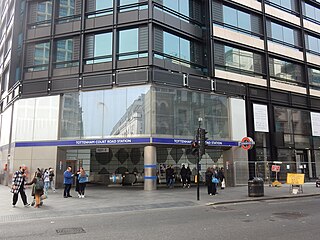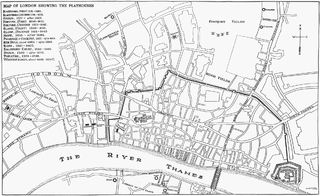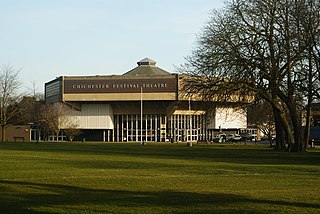
Tottenham Court Road is a London Underground and Elizabeth line station in St Giles in the West End of London. The station is served by the Central line, the Elizabeth line and the Charing Cross branch of the Northern line. The station is located at St Giles Circus, the junction of Tottenham Court Road, Oxford Street, New Oxford Street and Charing Cross Road and is in Travelcard Zone 1, with a second entrance at Dean Street.

The Globe Theatre was a theatre in London associated with William Shakespeare. It was built in 1599 at Southwark, close to the south bank of the Thames, by Shakespeare's playing company, the Lord Chamberlain's Men. It was destroyed by fire on 29 June 1613. A second Globe Theatre was built on the same site by June 1614 and stayed open until the London theatre closures of 1642. As well as plays by Shakespeare, early works by Ben Jonson, Thomas Dekker and John Fletcher were first performed here.

St Giles Circus is a road junction in the St Giles district of the West End of London at the eastern end of Oxford Street, where it connects with New Oxford Street, Charing Cross Road and Tottenham Court Road, which it is more often referred to owing to the location of Tottenham Court Road Underground station directly under the junction. It is near to Soho, Covent Garden, Bloomsbury and Fitzrovia.

Manchester City Centre is the central business district of Manchester, England, within the confines of Great Ancoats Street, A6042 Trinity Way, and A57(M) Mancunian Way, which collectively form an inner ring road. The City Centre ward had a population of 17,861 at the 2011 census.

The Curtain Theatre was an Elizabethan playhouse located in Hewett Street, Shoreditch, just outside the City of London. It opened in 1577, and continued staging plays until 1624.

Pitt Rivers Museum is a museum displaying the archaeological and anthropological collections of the University of Oxford in England. The museum is located to the east of the Oxford University Museum of Natural History, and can only be accessed through that building.

Blackfriars Theatre was the name given to two separate theatres located in the former Blackfriars Dominican priory in the City of London during the Renaissance. The first theatre began as a venue for the Children of the Chapel Royal, child actors associated with the Queen's chapel choirs, and who from 1576 to 1584 staged plays in the vast hall of the former monastery. The second theatre dates from the purchase of the upper part of the priory and another building by James Burbage in 1596, which included the Parliament Chamber on the upper floor that was converted into the playhouse. The Children of the Chapel played in the theatre beginning in the autumn of 1600 until the King's Men took over in 1608. They successfully used it as their winter playhouse until all the theatres were closed in 1642 when the English Civil War began. In 1666, the entire area was destroyed in the Great Fire of London.

An auditorium is a room built to enable an audience to hear and watch performances. For movie theatres, the number of auditoria is expressed as the number of screens. Auditoria can be found in entertainment venues, community halls, and theaters, and may be used for rehearsal, presentation, performing arts productions, or as a learning space.

His Majesty's Theatre is a West End theatre situated in the Haymarket in the City of Westminster, London. The building, designed by Charles J. Phipps, was constructed in 1897 for the actor-manager Herbert Beerbohm Tree, who established the Royal Academy of Dramatic Art (RADA) at the theatre. In the early decades of the 20th century Tree produced spectacular productions of Shakespeare and other classical works, and the theatre hosted premieres by such playwrights as Bernard Shaw, J. M. Synge and, later, Noël Coward and J. B. Priestley. Since the First World War the wide stage has made the theatre suitable for large-scale musical productions, and His Majesty's has accordingly specialised in hosting musicals. It has been home to record-setting musical theatre runs such as the First World War hit Chu Chin Chow and Andrew Lloyd Webber's The Phantom of the Opera, which has run at His Majesty's since 1986, except during the COVID-19 pandemic theatre closures.
Anne Butler Yeats was an Irish painter, costume and stage designer.

The Theatre Royal, Drury Lane, commonly known as Drury Lane, is a West End theatre and Grade I listed building in Covent Garden, London, England. The building faces Catherine Street and backs onto Drury Lane. The present building, opened in 1812, is the most recent of four theatres that stood at the location since 1663, making it the oldest theatre site in London still in use. According to the author Peter Thomson, for its first two centuries, Drury Lane could "reasonably have claimed to be London's leading theatre". For most of that time, it was one of a handful of patent theatres, granted monopoly rights to the production of "legitimate" drama in London.

A theater, or playhouse, is a structure where theatrical works, performing arts, and musical concerts are presented. The theater building serves to define the performance and audience spaces. The facility usually is organized to provide support areas for performers, the technical crew and the audience members, as well as the stage where the performance takes place.

Project Arts Centre is a multidisciplinary arts centre based in Temple Bar, Dublin, which hosts visual arts, theatre, dance, music, and performance.

David William Gentleman is an English artist. He studied art and painting at the Royal College of Art under Edward Bawden and John Nash. He has worked in watercolour, lithography and wood engraving, at scales ranging from platform-length murals for Charing Cross Underground Station in London to postage stamps and logos.

Chichester Festival Theatre is a theatre and Grade II* listed building situated in Oaklands Park in the city of Chichester, West Sussex, England. Designed by Philip Powell and Hidalgo Moya, it was opened by its founder Leslie Evershed-Martin in 1962. The smaller and more intimate Minerva Theatre was built nearby in 1989.

Sir Geoffrey Allan Jellicoe was an English architect, town planner, landscape architect, garden designer, landscape and garden historian, lecturer and author. His strongest interest was in landscape and garden design.

The Swan Theatre is a theatre belonging to the Royal Shakespeare Company in Stratford-upon-Avon, England. It is built on to the side of the larger Royal Shakespeare Theatre, occupying the Victorian Gothic structure that formerly housed the Shakespeare Memorial Theatre that preceded the RST but was destroyed by fire in 1926.
Michael Maddox was an English entrepreneur and theatre manager active in Imperial Russia. He was co-founder, with Prince Urusov, of the Petrovsky Theatre, the first permanent opera theatre in Moscow and predecessor of the Bolshoi Theatre.
Ebrahim Alkazi was an Indian theatre director and drama teacher. A rigid disciplinarian, he instilled in his acting students an awe and reverence that they still carry with them, with several of them having had the privilege of continuing the practice and training in the NSD Repertory Company, an introduction made to the National School of Drama by Alkazi. His standards later became very influential. He also remained the Director of National School of Drama, New Delhi (1962–1977) He was also a noted art connoisseur, collector and gallery owner, and founded the Art Heritage Gallery in Delhi with his wife, Roshen Alkazi.

TIFF Lightbox is a cultural centre in Toronto, Ontario, Canada, located in the first five floors of the Lightbox and Festival Tower on the north west corner of King Street and John Street.

















